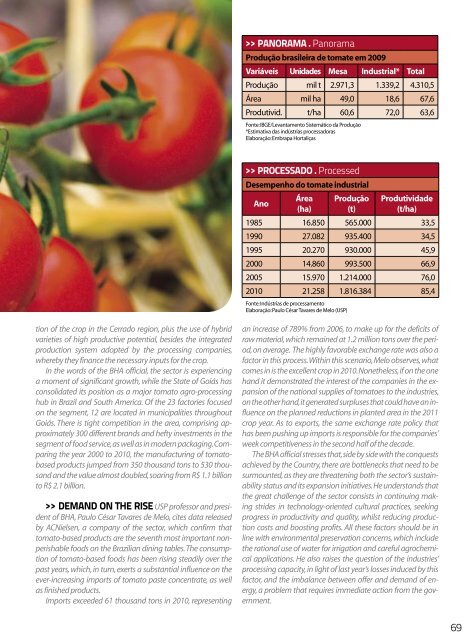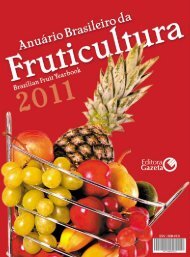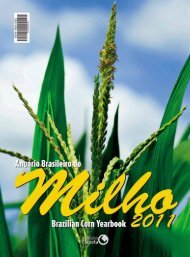tradicionalmenteinovador - Brazil Buyers & Sellers
tradicionalmenteinovador - Brazil Buyers & Sellers
tradicionalmenteinovador - Brazil Buyers & Sellers
You also want an ePaper? Increase the reach of your titles
YUMPU automatically turns print PDFs into web optimized ePapers that Google loves.
PANORAMA . Panorama<br />
Produção brasileira de tomate em 2009<br />
Variáveis Unidades Mesa Industrial* Total<br />
Produção mil t 2.971,3 1.339,2 4.310,5<br />
Área mil ha 49,0 18,6 67,6<br />
Produtivid. t/ha 60,6 72,0 63,6<br />
Fonte: IBGE/Levantamento Sistemático da Produção<br />
*Estimativa das indústrias processadoras<br />
Elaboração: Embrapa Hortaliças<br />
>> PROCESSADO . Processed<br />
Desempenho do tomate industrial<br />
Ano<br />
Área<br />
(ha)<br />
Produção<br />
(t)<br />
Produtividade<br />
(t/ha)<br />
1985 16.850 565.000 33,5<br />
1990 27.082 935.400 34,5<br />
1995 20.270 930.000 45,9<br />
2000 14.860 993.500 66,9<br />
2005 15.970 1.214.000 76,0<br />
2010 21.258 1.816.384 85,4<br />
Fonte: Indústrias de processamento<br />
Elaboração: Paulo César Tavares de Melo (USP)<br />
tion of the crop in the Cerrado region, plus the use of hybrid<br />
varieties of high productive potential, besides the integrated<br />
production system adopted by the processing companies,<br />
whereby they finance the necessary inputs for the crop.<br />
In the words of the BHA official, the sector is experiencing<br />
a moment of significant growth, while the State of Goiás has<br />
consolidated its position as a major tomato agro-processing<br />
hub in <strong>Brazil</strong> and South America. Of the 23 factories focused<br />
on the segment, 12 are located in municipalities throughout<br />
Goiás. There is tight competition in the area, comprising approximately<br />
300 different brands and hefty investments in the<br />
segment of food service, as well as in modern packaging. Comparing<br />
the year 2000 to 2010, the manufacturing of tomatobased<br />
products jumped from 350 thousand tons to 530 thousand<br />
and the value almost doubled, soaring from R$ 1.1 billion<br />
to R$ 2.1 billion.<br />
>> DEMAND ON THE RISE USP professor and president<br />
of BHA, Paulo César Tavares de Melo, cites data released<br />
by ACNielsen, a company of the sector, which confirm that<br />
tomato-based products are the seventh most important nonperishable<br />
foods on the <strong>Brazil</strong>ian dining tables. The consumption<br />
of tomato-based foods has been rising steadily over the<br />
past years, which, in turn, exerts a substantial influence on the<br />
ever-increasing imports of tomato paste concentrate, as well<br />
as finished products.<br />
Imports exceeded 61 thousand tons in 2010, representing<br />
an increase of 789% from 2006, to make up for the deficits of<br />
raw material, which remained at 1.2 million tons over the period,<br />
on average. The highly favorable exchange rate was also a<br />
factor in this process. Within this scenario, Melo observes, what<br />
comes in is the excellent crop in 2010. Nonetheless, if on the one<br />
hand it demonstrated the interest of the companies in the expansion<br />
of the national supplies of tomatoes to the industries,<br />
on the other hand, it generated surpluses that could have an influence<br />
on the planned reductions in planted area in the 2011<br />
crop year. As to exports, the same exchange rate policy that<br />
has been pushing up imports is responsible for the companies’<br />
week competitiveness in the second half of the decade.<br />
The BHA official stresses that, side by side with the conquests<br />
achieved by the Country, there are bottlenecks that need to be<br />
surmounted, as they are threatening both the sector’s sustainability<br />
status and its expansion initiatives. He understands that<br />
the great challenge of the sector consists in continuing making<br />
strides in technology-oriented cultural practices, seeking<br />
progress in productivity and quality, whilst reducing production<br />
costs and boosting profits. All these factors should be in<br />
line with environmental preservation concerns, which include<br />
the rational use of water for irrigation and careful agrochemical<br />
applications. He also raises the question of the industries’<br />
processing capacity, in light of last year’s losses induced by this<br />
factor, and the imbalance between offer and demand of energy,<br />
a problem that requires immediate action from the government.<br />
69





